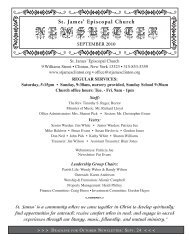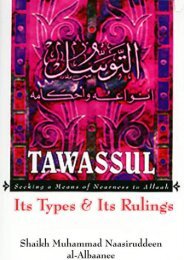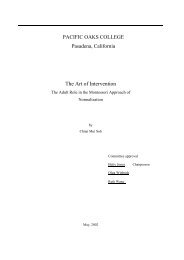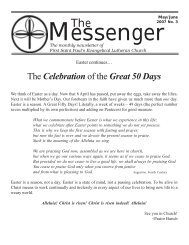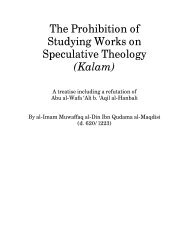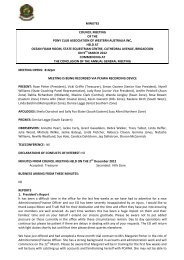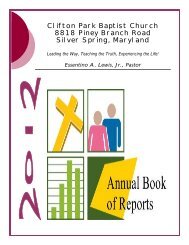Scripture and God in Christianity
Scripture and God in Christianity
Scripture and God in Christianity
You also want an ePaper? Increase the reach of your titles
YUMPU automatically turns print PDFs into web optimized ePapers that Google loves.
of a s<strong>in</strong>gle century, under the auspices of disciples of Jesus or their immediate successors. The<br />
collection is unlike the Koran <strong>in</strong> that it conta<strong>in</strong>s not a word written by the founder of the community,<br />
though his spoken words are recorded by evangelists <strong>and</strong> apostles <strong>and</strong> reflected <strong>in</strong> almost all<br />
the documents." 18<br />
The New Testament, as said, consists of twenty seven different books written by different <strong>in</strong>dividuals<br />
at various places, communities, <strong>and</strong> times. It has four widely known Gospels: the three<br />
Synoptic Gospels, as the term has been commonly used for Matthew, Mark, <strong>and</strong> Luke s<strong>in</strong>ce the<br />
n<strong>in</strong>eteenth century, <strong>and</strong> the fourth Gospel of John, the Acts of Apostles, fourteen Paul<strong>in</strong>e Epistles<br />
(the Greater as well as Pastoral) i.e., Romans, I & II Cor<strong>in</strong>thians, Galatians, Ephesians, Philippians,<br />
Colossians, I & II Thessalonians, I & II Timothy, Titus, Philemon <strong>and</strong> Hebrews, <strong>and</strong> the<br />
seven "Catholic" (mean<strong>in</strong>g "universally accepted") Epistles i.e., the letters of James, I & II Peter,<br />
I, II & III John, Jude <strong>and</strong> f<strong>in</strong>ally the book of Revelation.<br />
The New Testament with its present shape, number, <strong>and</strong> order, was not available to the early<br />
Christians for centuries after the departure of Jesus <strong>and</strong> his disciples. The New Testament writ<strong>in</strong>gs,<br />
observes Clarke, were "written for the special needs of particular groups of people, <strong>and</strong> the<br />
idea of comb<strong>in</strong><strong>in</strong>g them <strong>in</strong>to one authoritative volume was late <strong>and</strong> not <strong>in</strong> the m<strong>in</strong>d of the authors.<br />
Christians, therefore, <strong>and</strong> the Christian Church might conceivably have gone on <strong>in</strong>def<strong>in</strong>itely<br />
without Christian scriptures." 19 One of the lead<strong>in</strong>g factors may had be the existence of an<br />
already compiled Hebrew Bible. "Throughout the whole patristic age", observes Kelly, "as <strong>in</strong>deed<br />
<strong>in</strong> all subsequent Christian centuries, the Old Testament was accepted as the word of <strong>God</strong>,<br />
the unimpeachable sourcebook of sav<strong>in</strong>g doctr<strong>in</strong>e." 20 The compilation, collection, <strong>and</strong> identification<br />
of this particular group of writ<strong>in</strong>gs (the canonization process) as a dist<strong>in</strong>ct <strong>and</strong> authoritative<br />
entity resulted from a complex development with<strong>in</strong> the Christian Church. It took the Church 367<br />
years to produce a list of writ<strong>in</strong>gs <strong>and</strong> a canon that would conta<strong>in</strong> all the present day (New Testament)<br />
canonical writ<strong>in</strong>gs. The oldest <strong>in</strong>disputable witness to the New Testament canon is Athanasius,<br />
a fourth century bishop of Alex<strong>and</strong>ria. 21 He <strong>in</strong> his Easter letter of 367 wrote, "Forasmuch<br />
as some have taken <strong>in</strong> h<strong>and</strong>, to reduce <strong>in</strong>to order for themselves the books termed apocryphal,<br />
<strong>and</strong> to mix them up with the div<strong>in</strong>ely <strong>in</strong>spired scriptures... it seemed good to me also ... to set before<br />
you the books <strong>in</strong>cluded <strong>in</strong> the Canon, <strong>and</strong> h<strong>and</strong>ed down <strong>and</strong> accredited as Div<strong>in</strong>e." 22 The list<br />
that follows this prologue then conta<strong>in</strong>s the twenty seven books of our present New Testament<br />
though not <strong>in</strong> the same order. 23 These books are, accord<strong>in</strong>g to Athanasius, "the spr<strong>in</strong>gs of salvation,<br />
so that he that is thirsty can fill himself with the ( div<strong>in</strong>e ) responses <strong>in</strong> them; <strong>in</strong> these alone<br />
is the good news of the teach<strong>in</strong>g of the true religion proclaimed." 24<br />
The New Testament scholars differ widely over the process of compilation, authors, places,<br />
sources, dates, <strong>and</strong> history of the New Testament canon. The traditional or Orthodox scholars attribute<br />
almost all the New Testament writ<strong>in</strong>gs to the disciples or the immediate apostles; therefore<br />
declar<strong>in</strong>g the New Testament as an absolutely authentic <strong>and</strong> <strong>in</strong>spired work of the disciples or<br />
apostolic age, the first century A.D. For <strong>in</strong>stance, R. L. Harris claims, that "It seems clear that the<br />
New Testament books arose <strong>in</strong> the latter half of the first century A.D., <strong>and</strong> almost all of them<br />
were clearly known, reverenced, canonized, <strong>and</strong> collected well before a hundred years had<br />
passed." 25 Philip Scaff is more specific regard<strong>in</strong>g this issue: "Nearly all the books of the New<br />
Testament were written between the years 50 <strong>and</strong> 70, at least twenty years after the resurrection<br />
3





